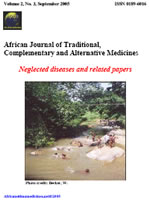
|
African Journal of Traditional, Complementary and Alternative Medicines
African Ethnomedicines Network
ISSN: 0189-6016
Vol. 7, No. 4, 2010, pp. 370-376
|
 Bioline Code: tc10050
Bioline Code: tc10050
Full paper language: English
Document type: Research Article
Document available free of charge
|
|
|
African Journal of Traditional, Complementary and Alternative Medicines, Vol. 7, No. 4, 2010, pp. 370-376
| en |
Chemotherapeutic Interaction Between Khaya Grandifoliola (Welw) Cdc Stem Bark Extract And Two Anti-Malarial Drugs In Mice
Steve O. Ijarotimi; Joseph M. Agbedahunsi; Cyprian O. Onyeji & Clement O. Adewunmi
Abstract
In malarial endemic countries especially in the tropics, conventional antimalarial drugs are used with herbal remedies either concurrently or successively. Khaya grandifoliola is one of such popular herbs used in the treatment of malaria. Various doses of ethanol extract of K. grandifoliola stem bark (50-400 mg/kg/day) were administered orally to Swiss albino mice infected with Plasmodium yoelii nigerense. A dose of 100 mg/kg/day of the extract was also combined with 2.5 mg/kg/day of chloroquine or 6.25 mg/kg/day of halofantrine in both early and established malaria infection test models. The results showed that in the early malaria infection test, K. grandifoliola in combination with chloroquine or halofantrine elicited enhanced antiplasmodial effect in the established infection, there was significantly greater parasite clearance following administration of the combination when compared to the effects of K. grandifoliola or the conventional drugs alone. The mean survival period of parasitized animals was also enhanced by the extract/halofantrine combination. Lower therapeutic doses of halofantrine may be required to potentiate parasite clearance when used in combination with K. grandifoliola. This may constitute great advantage to halofantrine which is associated with cardiotoxicity at high doses.
Keywords
Khaya grandifoliola, Antimalarial, Chemotherapeutic interaction, Chloroquine, Halofantrine
|
| |
© Copyright 2010 Afr. J. Trad. CAM.
Alternative site location: http://journals.sfu.ca/africanem/index.php/ajtcam
|
|
